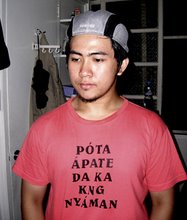Peanut Gallery
AFTER Totoy Bato, ArtiSta. Rita and Ara Muna, Kapampangan folk music is just about ready for its next reincarnation: RocKapampangan!
It's a term coined by a 20-year-old Kapampangan filmmaker from UP Diliman, Jason Paul Laxamana. It is also the title of a CD album he co-produced with the HAU Center for Kapampangan Studies.

RocKapampangan is not just an album, or an event; RocKapampangan is an idea whose time has finally come, because after folk, classical, acoustic and pop, Rock is the next and probably last frontier to be conquered by Kapampangan music.
In one of his recent visits to the Center, Andy Alviz could barely hide his excitement over a CD he had picked up from the sidewalks of San Fernando. It contained techno-pop versions of some ArtiSta. Rita songs recorded anonymously, as well as the Kapampangan version of "Sometimes When We Touch," entitled "O Joe Caluguran Da Ca," performed by the phenomenal Ara Muna.
Instead of making a fuss over the obvious piracy of ArtiSta, Rita songs, Andy Alviz gushed, "These versions prove that our songs will outlive us. Now I can die!" Never mind if nobody had asked his permission to rearrange his songs or record them; Andy Alviz was just too happy that more people are now listening to Kapampangan songs.
"What I will do is pirate this pirated CD, and make money on it," joked Alviz. "That will be the sweetest revenge."
The reawakening of public interest in traditional Kapampangan music can be attributed to many things and many people, but I can point to a single event that really started the ball rolling -- the launching of the double album "Pamalsinta qng Milabas," launched by the Sapni nang Crissot (Heirs of Crisostomo Soto), in the early 2000s at the Casino Filipino in Angeles City.
Before Pamalsinta, there were only the polosadores-folk singers who earned their living performing Kapampangan polosa and basulto during town fiestas and political rallies-and priests and laymen who composed Kapampangan church music for parish choirs.
What Pamalsinta did was, it took Kapampangan music beyond humid town plazas and choir lofts and put it in CD players inside air-conditioned bedrooms and cars of moneyed Kapampangans. After Pamalsinta, it was no longer bakya to sing "Atin Ku Pung Singsing."
Then came ArtiSta. Rita, which jazzed up Kapampangan folk songs and packaged their shows as big cultural events. ArtiSta. Rita raised the bar in the Kapampangan cultural scene, from the quality of recording to the quality of their live performances, which I think was the critical factor -- that is, had ArtiSta. Rita not been that good, or had the Broadway-trained Andy Alviz not been behind it but another person, the cultural renaissance that ArtiSta. Rita helped generate would have probably faltered early on. Their team-up with internationally acclaimed singer Mon David further gave Kapampangan music the class not found in other regions that have older and bigger recording industries.
With more Kapampangans now wanting more Kapampangan songs, the problem cultural workers are facing is how supply can meet the rising demand.
Local radio stations, cable TV, malls and schools are now willing to air Kapampangan songs and MTVs, and households across Pampanga and neighboring provinces are clamoring for Kapampangan songs to play during parties and programs. I was in Abucay and Hermosa last month and was delighted to know that even Tagalog residents in the two Bataan towns could sing Ara Muna's "O Joe Caluguran Da Ca" and Totoy Bato's "Carmencita." But I was worried because they were clamoring for new songs and none was coming.
RocKapampangan is a breakthrough album because it reaches out to the sector that's probably the hardest to reach-the youth, especially those that prefer their music gritty. Sixteen youth bands from Pampanga and Tarlac volunteered for this project. They are Asthma, Fine Time, Nora Aunor Fans Club, Pulse Rhythm, Silence, Mernuts, Amygdala, Cyclo, T.H.E.M., Neophytes, Mental Floss, 5 Against the Wall, Dialogo, Chilimansi, Tibuan and Fourth Clan. They were all given folk songs to rearrange into rock and then attended recording sessions in a local recording studio. They did all this free of charge.
In the two or three concerts where they have performed their Kapampangan rock songs, the audience seemed to have liked what they heard. Imagine rockers and punks with spiked hair and pierced tongues banging their heads to the tune of "O Atsi Kung Rosing" and shouting "Yeah! Cool!" when they heard "Sibul na ning Arayat." And when a rock band sang "Atin Ku Pung Singsing," they let out a really loud howl, as if to celebrate their ownership of the national anthem of Kapampangans.
Rock and Kapampangan were probably destined to merge from the very beginning. Fray Diego Bergaño, Fray Alvaro de Benavente and all the other early missionaries who wrote Kapampangan dictionaries and grammars agreed that ancient Kapampangans loved to sing.
Our ancestors did not merely recite their poems or tell their stories and epics; they sang them. They sang when they planted their crops and sang when they harvested them; they sang at every milestone in their life, from birth to courtship to marriage to death and burial; they sang throughout the dark night of prehistory to the dawn of history when the Spaniards came, and they sang all the way to the Revolution and Independence Day.
I even think that the Macabebe Scouts, those misunderstood and marginalized warriors from southern Pampanga, were history's first rockers because they had the look and attitude of longhaired, defiant rock singers. Thus, we put them on the cover of RocKapampangan, as a tribute.
RocKapampangan the album will be launched at the Plaza San Jose, Holy Angel University on Monday, February 18 at 5 p.m. Admission is free.
[The album is also in cooperation with the following: SM City Clark, Pizza Hut SM Clark, Pampanga Crusaders USA, Mr. Rene Romero of the Romac Group, Mr. Abong Tayag of Mother Earth Products, Advocacy for the Development of Central Luzon, Mr. Sonny Dobles, Mr. Rey Maniago, Ms. Jocelyn Fabello, and Mr. and Mrs. Jun Oliver Laxamana.]







1 comment:
I was crying inside when I am reading your column.It was a great
news for our cabalen all over the earth to hear this wonderful event that comes now in our lifetime.Masaya ku at proud ku keng kanakung ibatan. Ipala nako ning mayupaya at sana dacal pa ing datang king makanini at king bayung usbung nung nanu mang datang a bayu king kekatamung panaun.God Bless you Mr. Sisigman and more power.
Post a Comment